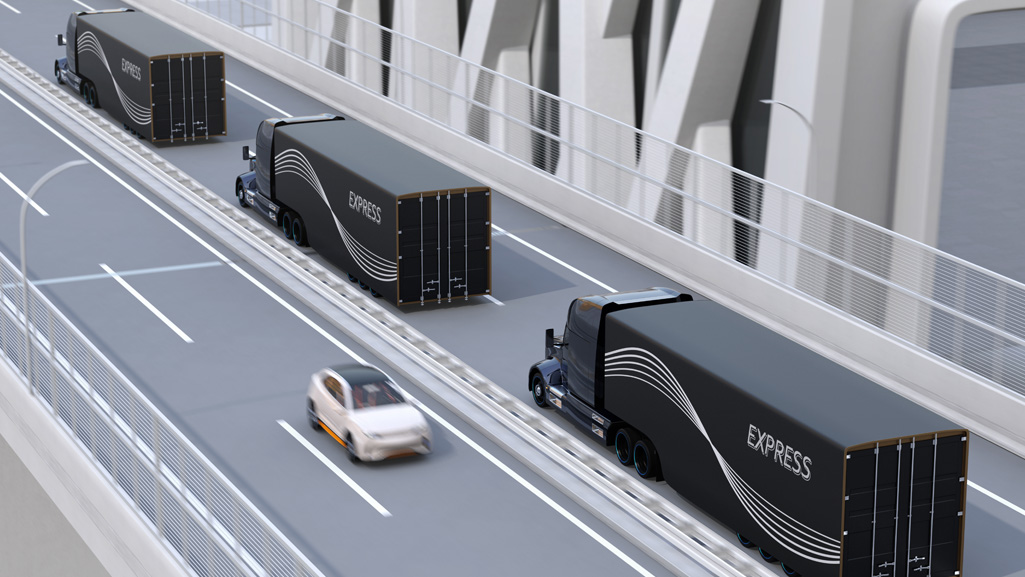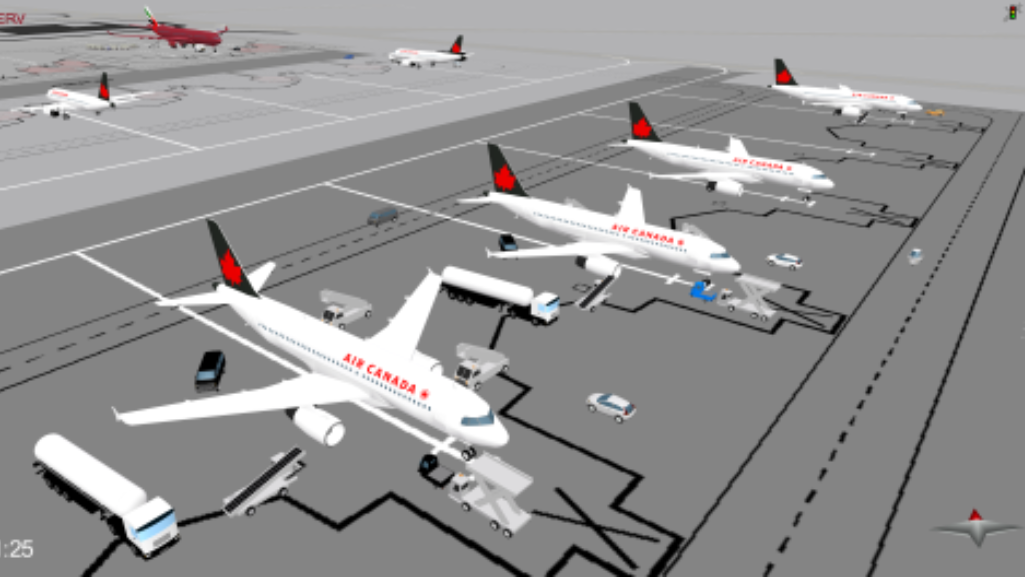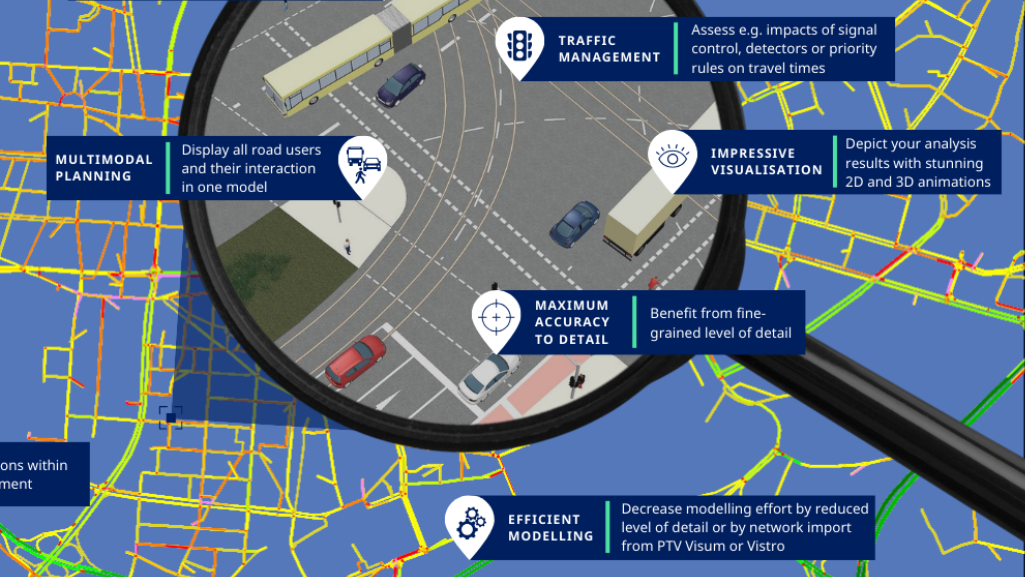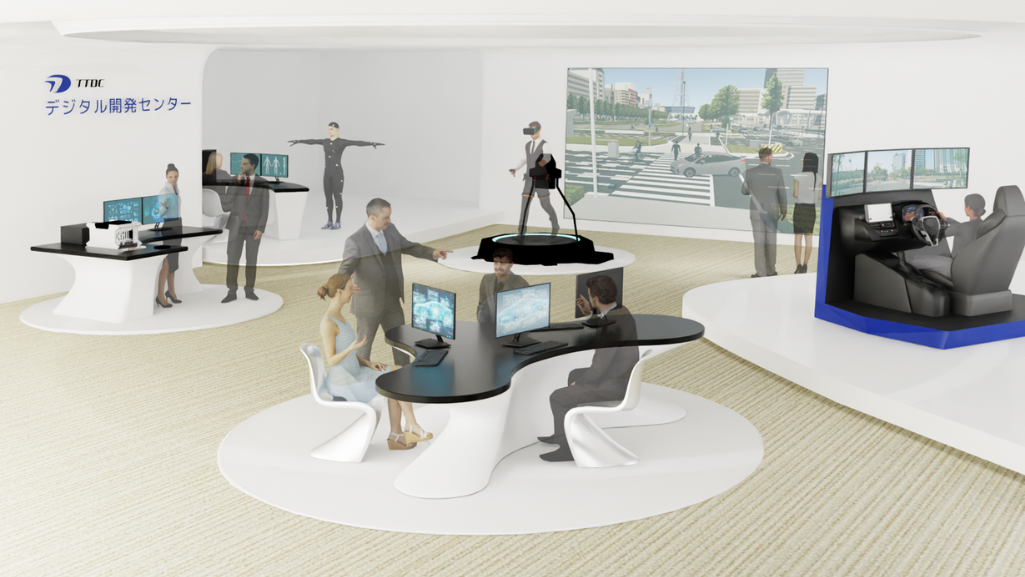Platooning is a concept that could revolutionize road transport. Progress in connecting and automating driving technology will make it possible to link trucks in order to form convoys. Researchers from all over the world are exploring this subject because of its scientific and commercial potential. A PTV team is currently working on a study using microscopic simulation to analyze the impact of platooning on traffic flow.
Technology works in real-world conditions
Platooning is an example of connected vehicle-to-vehicle communication (V2V). The platoon has a lead vehicle that transmits information to the vehicles behind it. This allows the trailing trucks to react almost simultaneously to the actions of the front truck, such as braking and steering. Platooning offers many advantages for long-distance journeys: trucks can operate at constant speed and remain closer to one another, which also means that there is reduced air resistance. It therefore reduces both fuel consumption and CO2 emissions. Platooning also improves safety, as faster response times minimize the risk of accidents. In case of an incident, the trailing trucks are alerted immediately and can react safely.
Pilot projects have shown that platooning technology requires little or no infrastructure development. In 2018, MAN Truck & Bus and DB Schenker conducted a research project to test connected trucks in daily logistics operations. For several months, two trucks equipped with advanced driver assistance systems drove on the highway between Munich and Augsburg, covering a total of 35,000 kilometers. The study also focused on the impact the new technology might have on drivers’ neurophysiological and psychosocial states.
The ENSEMBLE research project , which is funded by the European Union, aims to implement a Europe-wide deployment of platooning over the next three years. Truck manufacturers (Scania, Daimler, Iveco, MAN, Volvo, DAF, Renault), institutes and suppliers will work together to develop an integral multi-brand approach. Practical tests on closed testing grounds and in real life will help to assess the impact on traffic and infrastructure. The results will help to establish standards with the definition of a V2V communication protocol.
Simulation plays an essential role
In the 20 years they have been researching this topic, PTV experts have observed growing interest in platooning on the part of manufacturers and transport authorities due to the possibilities it offers for traffic operations, safety, and reducing environmental impact. Therefore, they are constantly working on innovations in this area.
With PTV’s software it possible to simulate connected autonomous vehicles and thus platoons in a virtual environment. Various scenarios, on any lane or infrastructure, can be tested and analyzed.
Jochen Lohmiller Principal Product Manager for Microsimulation Mobility at PTV Group, notes: “There are some platooning pilots in the field. However, the impact of autonomous truck platoons in coexistence with conventional vehicles has not yet been sufficiently studied. Since these systems are still in their early development stages and their effects on our roads are only theoretical, simulation plays an essential role.”
The impact of platooning on traffic flow
In a recent study, PTV experts analyzed the impact of platoons of 3 to 8 trucks on traffic flow. Two environments were modeled in PTV Vissim: A simple highway network with oversaturated traffic conditions in order to explore thoughput variations And an existing network – the model of a four-lane road corridor, located between Eindhoven and Helmond in the Netherlands, with multiple adjacent facilities, such as arterial and urban roads.
One of the objectives was to demonstrate how platooning can improve operations without the need for advanced signaling systems along the corridor.
“In the study, we didn’t focus on vehicle dynamics within the platoon. We analyzed how stable platoons and their configurations as well as all related parameters affect traffic flow on different types of roads,” explains Jochen Lohmiller.
The microsimulation software provided a detailed and realistic model of the actual traffic in different scenarios, which made it possible to determine the conditions for an optimal traffic flow. The analysis demonstrated the advantages of platoon formations in terms of performance and road capacity – not only for trucks, but also for passenger cars.
Within the research community, a lot of effort has been made in the development of algorithms to achieve stability in theplatoons as a prerequisite for safe and efficient traffic. That is why, as part of the study, the PTV experts also examined previous research on platoon parameters and their possible value for the PTV algorithms. And they were able to validate the platooning algorithm implemented in PTV Vissim 2020, within the framework of CoEXist – a European research project that focuses on the interaction between semi-automated and conventional vehicles during the transition period to fully autonomous vehicle fleets.
Simulation in academic studies
Simulation software now opens up many new possibilities. Future projects can, for example, focus on platoon formation and dissolution. To date, no fewer than 307 academic studies on platooning have benefited from the PTV simulation tool. The company offers a special academia program that offers students, teachers, and researchers, a wide range of opportunities to support their studies.
The PTV study is also a technological showcase. It will serve to enrich publications dedicated to the field and bring a documented light on the functioning of the software to the users concerned: companies, scientists, consultants, cities, as well as universities and major schools.
Another long way to go?
Thanks to pilot studies, simulations and the constant improvement of driver assistance systems, platooning is becoming a more realistic possibility all the time. Experts are optimistic that we might see the first platoons of semi-autonomous trucks on our highways in the next 5 years. However, major questions about the impact of truck convoys on road safety and the legal framework of platooning still need to be defined. One example: In platoons, the minimum distance between two trucks might be reduced from 50 meters to 10 meters – something that needs to be adjusted in the law.
This was also one of the conclusions of the PTV study. Peter Sukennik, PTV Vissim Technical Product Manager, one of the authors, emphasizes: “There is still much uncertainty about how platoons will work in the future, especially concerning their lane change behavior and how exactly vehicles will join and leave the convoy. Will vehicles driving at a required speed be allowed to temporarily increase their speed to reach and join the platoon? Will platoons “wait” for appropriate arrangements? Or will they actively move towards platoon-capable vehicles? Many questions are still unanswered. The combination of tests on our roads and simulation in virtual environments will help to find the answers.”



